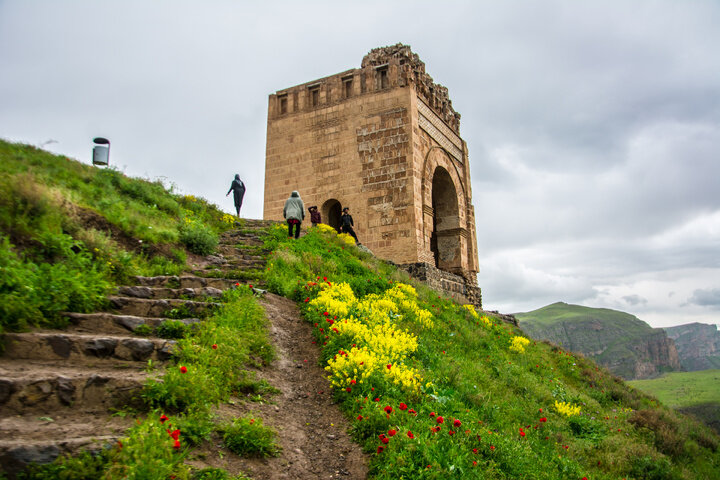Hashtrud’s Zahhak castle, a testament to Iranian history, mythology, and identity

TEHRAN--Zahhak castle in Hashtrud, East Azarbaijan province, is one of the prominent examples of rock and military architecture. It is today at the center of the restoration, research, and development-oriented programs of East Azarbaijan Cultural Heritage, Tourism, and Handicrafts Department.
Zahhak castle is intended not only to be on the path of cultural revival, but also to become one of the country's cultural tourism hubs, CHTN reported.
Vahid Navadad, the deputy head of East Azarbaijan Cultural Heritage, Tourism, and Handicrafts Department, said, “We intend to introduce and promote the infrastructures pertaining to this historical castle.”
Based on stratigraphic studies and historical documents, renovations are underway in the main entrance and eastern wing of the castle, he said.
He added that preserving Zahhak castle means preserving part of the historical memory of the region and cultural identity of Azarbaijan.
“Our approach is to have minimum restoration with respect to originality of materials and historical form of the monument,” he mentioned.
The unique tourism potentials of Zahhak castle can turn into one of the pillars of sustainable development in the region, he said.
Also, Alireza Bairamzadeh, the deputy head of East Azarbaijan Tourism Department, said Zahhak castle is not just a place to visit, but a lived experience: a combination of history, nature, mythology, and architecture. “Our plan is to prepare the ground for attracting cultural tourists by improving access routes, installing multilingual information boards, and developing basic infrastructure.”
“We are compiling ecotourism plans with participation of local community so that tourism in this region not only leads to economic prosperity but also lays the groundwork for the transfer of cultural values. We plan specialized tours with focus on mythological and historical studies to draw elite tourists to the region.”
Also, Ahmad Hamzehzadeh, the director general of East Azarbaijan Cultural Heritage, Tourism, and Handicrafts Department, said, “We view Zahhak Castle not just as a historical monument, but also as a living asset for recreating the region's identity.”
“Negotiations are underway for attracting cultural investors with the aim of launching a museum site, implementing night tourism programs, and even developing access routes to the area. Apart from preserving the historical originality of the castle, these measures can turn into a driving force for economic growth of Hashtrud and its surrounding areas,” he concluded.
Zahhak Castle, named after the mythical figure Zahhak from ancient Iranian mythology, dates back to the second millennium BC, with continued occupation through the Timurid era.
The fortress, which features intricate brickwork, archways, and staircases, offers insights into ancient defensive architecture and societal structures.
The castle’s strategic importance during the Parthian period is underscored by historical accounts, including its role in the defeat of Roman general Marc Antony in 37 BC.
The Median infantry, allied with the Parthian cavalry, played a crucial part in this victory, providing a rare glimpse into the military strategies of the era.
Archaeological excavations, initiated by British researchers decades ago, have revealed artifacts such as stucco remnants with traces of coloring, shedding light on the site’s artistic and cultural heritage.
Glimpses of Parthian era
The Parthian Empire, also known as the Arsacid Empire, was a major Iranian political and cultural power centered in ancient Iran from 247 BC to 224 CE. Its name derives from its founder, Arsaces I, who led the Parni tribe in conquering Parthia, a northeastern region of Iran. At the time, Parthia was a satrapy (province) under Andragoras, a rebel against the Seleucid Empire.
At its zenith, the Parthian Empire extended from the northern Euphrates River (modern central-eastern Turkey) to present-day Afghanistan and western Pakistan. Positioned along the Silk Road, the empire thrived as a hub for trade and commerce, connecting the Roman Empire in the Mediterranean to the Han dynasty in China.
The Parthians assimilated various elements of the diverse cultures within their empire, which included Persian, Hellenistic, and regional influences. Initially, the Arsacid court adopted many aspects of Greek culture but gradually saw a revival of Iranian traditions. Parthian rulers adopted the title “King of Kings”, asserting their heritage from the Achaemenid Empire. Unlike the Achaemenids, who governed through centrally appointed satraps, the Parthians often allowed local kings to serve as vassals. As the empire expanded, its central government shifted from Nisa to Ctesiphon, near modern Baghdad, though other cities also served as capitals.
KD
Leave a Comment